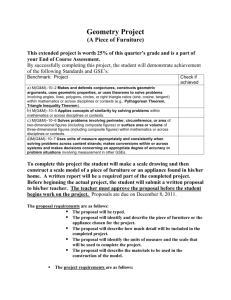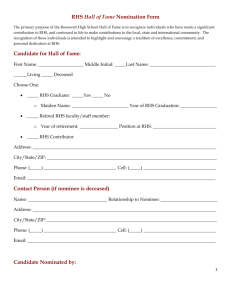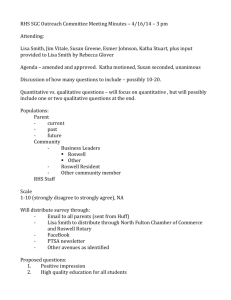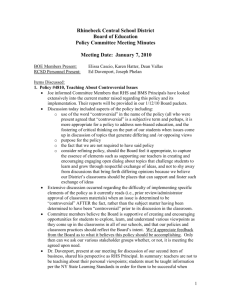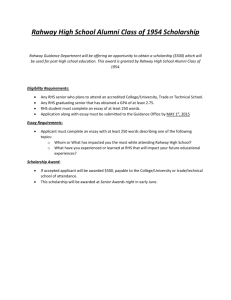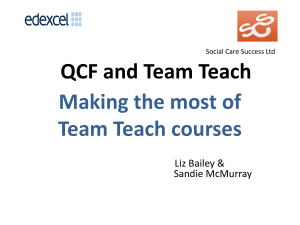RHS Level 2 Plant Growth & Propagation Qualification
advertisement
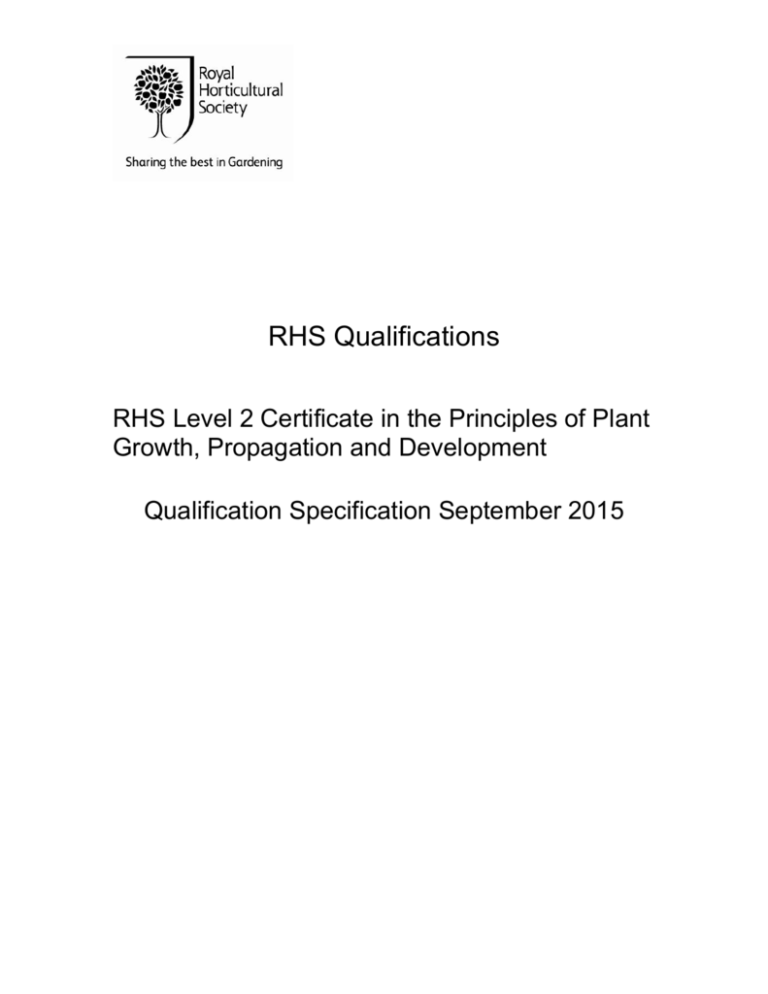
RHS Qualifications RHS Level 2 Certificate in the Principles of Plant Growth, Propagation and Development Qualification Specification September 2015 Contents 1. RHS Qualifications Contact Details 3 2. Equality and Diversity Policy Statement 3 3. RHS Level 2 Certificate in Plant Growth, Propagation and Development 4 Introduction 4 Credit Value 4 Teaching Pattern 4 Qualification Structure 5 Assessment 5 Language 5 Learning Resources 5 Grading 6 4. Approved Centres 6 5 Candidate Registration 6 6. Reasonable Adjustments and Special Consideration 7 7. Enquiry about Results Service 7 8. Examination Dates 7 9. Fees 8 10. Unit Equivalents 8 11. Appeals Procedure 9 12. Policy on Malpractice and Maladministration 9 13. Units Plant classification, structure, and function 10 Plant nutrition and the root environment 16 Maintaining plant health 21 Understanding plant propagation 25 © – The Royal Horticultural Society RHS Registered Charity No: 222879/SC038262 Q-QAO Qualification Specification QCF Level 2 PoPG, P & D v18 03.09.15 2 1. RHS Qualifications Contact Details RHS Qualifications is the Awarding Organisation of the Royal Horticultural Society. RHS Qualifications RHS Garden Wisley Woking Surrey GU23 6QB UK Tel: 01483 226500 Email: qualifications@rhs.org.uk Approved Centre Web Portal: www.rhsq.org.uk 2. Equality and Diversity Policy Statement RHS Qualifications is committed to policies that will promote equal opportunities in all its operations, regardless of age, disability, ethnic origin, gender, marital status, religion, sexual orientation or any other factor. RHS Qualifications is committed to ensuring that there is no unfair discrimination in any of its operations and will take into account all current legislation in relation to the equality of opportunity. RHS Qualifications will constantly monitor and review its policies and practices pertaining to equal opportunities, to ensure that they remain consistent with its equal opportunities objectives and continue to comply with all relevant legislation. RHS Qualifications will strive to make awareness of and respect for equality and diversity, an integral part of the culture of the organisation. A copy of the RHS Qualifications Equality and Diversity Policy is available on the Approved Centre Web Portal. © – The Royal Horticultural Society RHS Registered Charity No: 222879/SC038262 Q-QAO Qualification Specification QCF Level 2 PoPG, P & D v18 03.09.15 3 3. RHS Level 2 Certificate in the Principles of Plant Growth, Propagation and Development 3.1 Introduction This qualification provides a route to employment in professional horticulture by assessing knowledge of the scientific principles underpinning horticultural practices, and supports career development for those already working in the profession. It also provides a foundation for further learning or training in the field of horticulture. There are no pre-requisites for entry to the qualification The qualification is accredited within the Qualifications and Credit Framework. Accreditation Number: 601/0554/9 3.2 Credit Value The qualification has a credit value of 14. This equates to 140 learning hours. Learning time is defined as the time taken by learners at the level of the qualification, on average, to complete the learning outcomes of the units to the standard determined by the assessment criteria. Guided Learning Hours (GLH) are the number of hours of face-to-face tutor contact recommended to complete the qualification. Guided Learning Hours are always less than the total learning hours, as learners are expected to complete a certain amount of study in their own time. The Guided Learning Hours for the qualification are 107 hours. 3.3 Teaching Pattern The qualification is designed to be studied on a part-time basis. No particular teaching pattern is specified, and centres offering courses leading to the qualification are free to define their own teaching structure and teaching hours. © – The Royal Horticultural Society RHS Registered Charity No: 222879/SC038262 Q-QAO Qualification Specification QCF Level 2 PoPG, P & D v18 03.09.15 4 3.4 Qualification Structure The qualification will be awarded to those who gain the credits for the following four mandatory units: RHS Ref R2101 Unit Plant classification, structure, and function Unit reference number K/505/2967 Credits 5 Level 2 R2102 Plant nutrition and the root environment Unit reference number R/505/2834 3 2 R2103 Maintaining plant health Unit reference number Y/505/2835 3 2 R2104 Understanding plant propagation Unit reference number D/505/2965 3 2 3.5 Assessment Each unit will be assessed by a separate written examination covering all learning outcomes specified in the unit. Examinations must be taken in a centre approved by RHS Qualifications, or under arrangements for exceptional supervision agreed by RHS Qualifications. Examinations must be conducted in accordance with the RHS Regulations for the Conduct of Examinations. Examinations will be offered twice a year in February and June. Past examination papers including the examiner’s comments are published for the past six examination sessions. These are available for download under the appropriate qualification section of the RHS website. 3.6 Language Examinations will be offered in English. 3.7 Learning Resources There is a wide range of books and other learning resources published which support the studies of those learning horticulture. RHS Qualifications does not recommend or endorse any specific learning resources as meeting the needs of learners studying for RHS qualifications. Learners are encouraged to seek guidance from their tutors on which resources best support their studies, or to choose the most appropriate resources for their needs from the wealth of material available. © – The Royal Horticultural Society RHS Registered Charity No: 222879/SC038262 Q-QAO Qualification Specification QCF Level 2 PoPG, P & D v18 03.09.15 5 3.8 Grading Credits for a unit will be awarded to a candidate who achieves a mark of 50% or more in the written examination for that unit. Where a candidate achieves a mark of 70% or more in the examination for the unit, the credits for the unit will be awarded with commendation. Unit Mark Pass with Commendation Pass RHS Ref R2101 Plant classification, structure, and function 100 70 50 R2102 Plant nutrition and the root environment 60 42 30 R2103 Maintaining plant health 60 42 30 R2104 Understanding plant propagation 60 42 30 Where a candidate receives credits with commendation in all four mandatory units, the qualification will be awarded with commendation. 4. Approved Centres Centres wishing to offer examinations leading to RHS qualifications must be approved by RHS Qualifications. Applications for approval should be sent to the Quality Assurance and Relationships Officer at the contact details in section 1. 5. Candidate Registration Candidates should be registered for examinations in the units of the qualification through the RHS Qualifications Web Portal. Approved Centres undertake to obtain on behalf of their learners a Unique Learner Number (ULN) and a learner record, unless the learner chooses not to have one. If centres supply an email address for candidates at the time of registration, candidates will be invited to open an account on the RHS Qualifications Web Portal, and will be able to view their examination history, their current registrations, and their results when available. © – The Royal Horticultural Society RHS Registered Charity No: 222879/SC038262 Q-QAO Qualification Specification QCF Level 2 PoPG, P & D v18 03.09.15 6 6 Reasonable Adjustments and Special Consideration RHS Qualifications is committed to ensuring fair assessment for all candidates, and will facilitate access to its qualifications through reasonable adjustments to assessment arrangements for candidates with an identified specific need. An example of a reasonable adjustment which could be made is the production of a modified examination paper for a candidate with a visual impairment. Special consideration is given following the examination to candidates who are present for the examination but may have been disadvantaged by temporary illness, injury or adverse circumstances which arose at, or near, the time of examination. Full guidance is provided in the document ‘Guidance to Centres for Reasonable Adjustments and Special Consideration’. The document is available on the RHS website (www.rhs.org.uk), the RHS Qualifications Approved Centre Web Portal, or can be obtained from RHS Qualifications. Applications for reasonable adjustments or special consideration must be made by the Approved Centre on behalf of the candidate. Application must be made within specified timescales. 7. Enquiry about Results service The following service is available to candidates who have a query regarding their examination result: Re-mark and Feedback Re-marking of the examination paper by an independent examiner. Feedback will be provided identifying areas of strength and weakness with constructive suggestions for improvement. Candidates requesting a re-mark need to be aware that grades may go down as a result of the re-marking. Applications for the ‘Enquiry about Results Service’ must be made through the Approved Centre where the candidate registered for the examination. This service will be available for 28 days from the date of release of the results to Approved Centres on the RHS webportal. 8. Examination Dates For a full list of examination dates please see the Qualifications and Credit Framework Examination Dates, this document is available on the Qualifications page on the RHS website and on the RHS Webportal. © – The Royal Horticultural Society RHS Registered Charity No: 222879/SC038262 Q-QAO Qualification Specification QCF Level 2 PoPG, P & D v18 03.09.15 7 9. Fees For a full list of fees please see the Qualifications and Credit Framework Fees Notice, this document is available on the Qualifications page on the RHS website and on the RHS Webportal. All fees are payable prior to confirmation of service or entry for the examination. Late Entries RHS Qualifications publishes annually, and distributes to Approved Centres, the closing dates of entry for each examination for the following year. Entries submitted after the published closing date will be subject to a late entry fee. The total fee charged for late entries is twice the standard examination fee for each unit Replacement Certificate (if lost, damaged or destroyed) The fee for a replacement certificate can be found on the Qualifications and Credit Framework Fees Notice. Please send your request to the Qualifications Department. Re-mark & Feedback The fee for a remark and feedback can be found on the Qualifications and Credit Framework Fees Notice. If a re-mark results in an upgrade of the result, the fee paid will be refunded 10 Unit Equivalents Below is a table listing unit equivalances that have been granted for this qualification. Candidates who have been awarded a unit credit certificate for the previous unit number will not receive a unit certificate for the equivalant unit number. Current Equivalent Unit Number K/505/2967 R/505/2834 Y/505/2835 D/505/2965 Previous Unit Number H/601/0307 A/601/0314 K/601/0342 M/601/0343 © – The Royal Horticultural Society RHS Registered Charity No: 222879/SC038262 Q-QAO Qualification Specification QCF Level 2 PoPG, P & D v18 03.09.15 8 11. Appeals Procedure An Appeals procedure exists to conduct appeals lodged by candidates against decisions made by RHS Qualifications, concerning their examination performance, the granting of an award and/or the closure of their entry to an award on academic grounds. The procedure is also followed in cases where there is irregularity or malpractice in the conduct of examinations and where RHS Qualifications has imposed a penalty on a candidate, tutor or invigilator, and the Centre wishes to appeal against this decision after results are published. A copy of the procedure is available on the RHS Qualifications Web Portal and on the RHS website. 12. Policy on Malpractice and Maladministration Malpractice consists of those acts which undermine the integrity and validity of the assessment or examination, the certification of qualifications and/or damage the authority of those responsible for conducting the assessment, examination and certification. RHS Qualifications does not tolerate actions or attempted actions of malpractice by learners or centres in connection with RHS qualifications. RHS Qualifications may impose penalties and/or sanctions on candidates or centres where incidents, or attempted incidents, of malpractice have been proven. A copy of the full policy is available on the RHS Qualifications Web Portal and on the RHS website. © – The Royal Horticultural Society RHS Registered Charity No: 222879/SC038262 Q-QAO Qualification Specification QCF Level 2 PoPG, P & D v18 03.09.15 9 Plant classification, structure and function RHS reference number: R2101 Unit reference number: K/505/2967 Unit equivalent to: H/601/0307 Unit guided learning: 38 Level: Level 2 Credit Value: 5 Unit purpose and aim(s): This unit will enable candidates to develop an understanding of the basis on which higher plants are classified and named, and to appreciate the role and function of morphological and anatomical features in higher plants. The unit will ensure that the fundamental physiological processes within the plant are understood including photosynthesis, respiration and water movement. Additionally students will understand the mechanisms of pollination, fertilisation, seed formation and subsequent germination. Learning outcome The Learner will Assessment criteria The learner can Indicative column The learner should be able to 1. Know the characteristics and the naming of the main groups of plants and their life cycles. 1.1 Describe plant groups of significance to horticulture. Identify the differences between conifers and flowering plants; conifers - mostly evergreen, woody, cones, and naked seeds, perennials. Flowering plants - evergreen and deciduous, herbaceous and woody, flowers and enclosed seeds, all life cycles. Describe the differences between monocotyledons and dicotyledons: features of root, stem, leaf, flower and seed including internal arrangements of vascular bundles in stems and roots. 1.2 Understand botanical and horticultural plant names. State the reasons why botanical plant names are important. Stability, uniqueness, internationally understood, confusion over common names allows plant identification and communication. Describe the binomial system of naming plants. State the meaning of the terms ‘genus’ and ‘species’ and state how they are written, with reference to THREE plant examples. Describe the naming of cultivated plants. State the meaning of the term cultivar and state how it is written with reference to three plant examples. 1.3 Describe the stages in plant growth. © – The Royal Horticultural Society RHS Registered Charity No: 222879/SC038262 Q-QAO Qualification Specification QCF Level 2 PoPG, P & D v18 03.09.15 Describe the stages of the life-cycle of a plant: seed, juvenile (vegetative), adult (reproductive), senescence, death and their significance for horticulture. 10 1.4 Define a range of botanical and horticultural terms relating to plant growth. Define the botanical terms: ‘annual’, ‘ephemeral’, ‘biennial’ and ‘perennial’ and the horticultural meanings of ‘annual’, ‘biennial’ and ‘perennial’. (An example of different meanings is that Dipsacus fullonum (teasel) is a true biennial, Erysimum cheirii (wallflower) is used as a biennial in horticulture but is a perennial). Define the botanical terms: ‘herbaceous’, ‘woody’, ‘evergreen’, ‘semi-evergreen’. Define the horticultural terms: ‘tender perennial’, ‘half hardy annual’, and ‘hardy annual’. (A ‘tender perennial’ cannot survive frost; a ‘half hardy annual’ is sown under protection early in the season then planted out; a ‘hardy annual’ is sown in situ). Define the terms ‘shrub’ and ‘tree’. TWO plant examples should be known for EACH term. 2. Know the structure and function of plant cells, tissues and vegetative organs. 2.1 Describe the structure of plant cells and state the functions of plant cell components and tissues. Draw a typical plant cell. State the function of: cell wall, cell membrane, nucleus, vacuole, cytoplasm, chloroplast & mitochondrion. Describe where cell division is located within the plant - apical and lateral meristems. Describe how plants increase in size – cell division and enlargement (NO DETAILS OF MITOSIS ARE REQUIRED). 2.2 Describe the characteristics and state the function of plant tissues. State what is meant by the term ‘plant tissue’. 2.3 Describe the structure and state the functions of roots. State the primary functions of the root anchorage, water and mineral uptake. Describe the characteristics and function of: protective (epidermis), meristematic (cambium), transport (phloem, xylem) and packing (parenchyma) plant tissues. Describe root types - ‘tap’, ‘lateral’, ‘fibrous’ and ‘adventitious’, to include the origin of each type e.g. tap root from radicle, adventitious roots from stem. Describe the difference between monocotyledon and dicotyledon roots. © – The Royal Horticultural Society RHS Registered Charity No: 222879/SC038262 Q-QAO Qualification Specification QCF Level 2 PoPG, P & D v18 03.09.15 11 Describe the structure of the root and state the function of its components - internal and external structures to include drawings of transverse and longitudinal sections through a young dicotyledon root to show the following components: root cap, apical meristem, zone of elongation, zone of differentiation, root hairs, epidermis, cortex, endodermis, pericycle, phloem, xylem and cambium. Describe how the root is adapted to perform other functions - storage/perennation, tap root (Daucus) and root tuber (Dahlia), climbing (Hedera) and support/prop (Zea). 2.4 Describe the structure and state the functions of stems. State the primary functions of the stem - holding leaves and flowers in optimum positions and transport between roots and leaves. Describe the structure of the stem and state the functions of its components - internal structures to include drawing of a transverse section through a young dicotyledon stem to show the following components: epidermis, cortex, cambium, phloem, xylem, pith, vascular bundle and external structures to include lenticels, nodes, axillary and apical buds, scars (scale and leaf). Describe how the stem is adapted to perform other functions - protection: stem spines (thorns of Crataegus) and prickles of Rosa; storage/perennation: corms (Crocus) stem tubers (Begonia) and rhizomes (Iris gemanica), climbing: (Wisteria passiflora); natural vegetative reproduction: stolons/runners (Fragaria), rhizomes (Festuca rubra), stem tubers (Solanum tuberosum). 2.5 Describe the structure and state the functions of leaves. State the primary function of leaves – photosynthesis. Describe: petiole, lamina, veins, and midrib. Leaf shape, colour and leaf arrangement on the stem – simple, compound (palmate, pinnate). Draw a dicotyledon leaf section to show the following components epidermis, xylem, phloem, veins, palisade & spongy mesophyll, cuticle, guard cells and stomata. Describe how leaves are adapted to perform other functions - storage/perennation by bulbs, © – The Royal Horticultural Society RHS Registered Charity No: 222879/SC038262 Q-QAO Qualification Specification QCF Level 2 PoPG, P & D v18 03.09.15 12 (Narcissus and Lilium) and water storage (Sedum), protection by leaf spine (Berberis), climbing by tendrils (Lathyrus) and twining petioles (Clematis) and attraction of pollinators by bracts (Hydrangea). 3. Understand the 3.1 Describe the structure and function structure and state the of flowers fruits and functions of flowers. seeds. State the functions of flowers: to aid pollination, give rise to seeds and fruits. Draw a vertical section of a monocotyledon flower (not grass) and a dicotyledon flower to show where appropriate: receptacle, tepal, sepal, petal, calyx, corolla, nectary, anther, filament, stamen, stigma, style, ovary and ovule. State the meaning of ‘monoecious’ and ‘dioecious’ in relation to plants. Know TWO examples of each. State the meaning of the term ‘pollination’. Describe the characteristics of wind and bee pollinated plants - variations in flower structure and pollen. 3.2 Describe the structure and functions of fruits and seeds. State the meaning of the term ‘fertilisation’ fusion of a male gamete from pollen with a female gamete in the ovule to produce the embryo. State the meaning of the terms ‘fruit’ and ‘seed’ a fruit is formed from the ovary after fertilisation. A seed is formed from the ovule after fertilisation. State the function of fruits and seeds - Fruit: distribution and protection of the seed and may impose dormancy. Seed: distribution and protection of the embryo, may impose dormancy, gives rise to new plants. Describe the means by which seeds are dispersed - wind: (wing, parachute and censer (papaver)); water*; explosive; animals: (attachment, scatter hoarding and frugivory). TWO plant examples for EACH of the above except where indicated * where only ONE is required. Describe the internal and external structure of the seed and state the function of the various parts: testa, cotyledon, embryo, radicle, plumule, hypocotyl, epicotyl, endosperm, hilum, micropyle. Examples to be studied to include French bean (Phaseolus vulgaris) and broad bean (Vicia faba). © – The Royal Horticultural Society RHS Registered Charity No: 222879/SC038262 Q-QAO Qualification Specification QCF Level 2 PoPG, P & D v18 03.09.15 13 Describe ONE example of epigeal germination and ONE example of hypogeal germination, germination of French bean (Phaseolus vulgaris), and broad bean (Vicia faba). 4. Understand the importance of photosynthesis, respiration, and the movement of water and minerals through the plant. 4.1 Describe photosynthesis and the factors that affect it. State the equation for photosynthesis in words (carbon dioxide, water, sugars, oxygen) and state the necessity for chlorophyll and light. List the environmental factors that affect the rate of photosynthesis: temperature, light (intensity, quality/PAR and duration), carbon dioxide, water and mineral nutrients. NO DETAILS OF WAVELENGTH ABSORPTION & ACTION SPECTRA ARE REQUIRED. Describe how these factors affect the rate of photosynthesis: to include Law of Limiting Factors and how growers can optimise the conditions for photosynthesis. NO DETAILS OF METHODS ARE REQUIRED. 4.2 Describe aerobic and anaerobic respiration and the factors that affect them. State the equations for aerobic and anaerobic respiration in words: Aerobic: sugars, oxygen, water, carbon dioxide, high yield of energy. Anaerobic: sugars, ethanol, carbon dioxide, low yield of energy. List the factors that affect the rate of respiration: oxygen and temperature. Describe how these factors affect the rate of aerobic respiration. Describe the significance of anaerobic and aerobic respiration in horticultural situations: waterlogging, propagation, produce storage, seed storage. 4.3 Describe the movement of water and minerals through the plant. © – The Royal Horticultural Society RHS Registered Charity No: 222879/SC038262 Q-QAO Qualification Specification QCF Level 2 PoPG, P & D v18 03.09.15 Distinguish between diffusion and osmosis to include: gaseous and liquid diffusion, transpiration, and water uptake. Identify examples of diffusion in plants, to include: transpiration and gaseous exchange. 14 Identify examples of osmosis in plants, to include: water uptake into cells, turgor, and cell expansion. Describe the pathway of water movement from the soil through the plant into the atmosphere soil water: pathway across the root (root hairs, osmosis across root cells, flow through root cell walls, endodermis); transport through xylem of stem (transpiration pull): pathway across leaf, (xylem in veins, osmosis across leaf cells, flow through leaf cell walls, evaporation from leaf cell walls into mesophyll spaces); diffusion through stomata of leaf. DIAGRAM OF PATHWAY REQUIRED. State what is meant by the term ‘transpiration’. List the factors that affect the rate of transpiration: relative humidity, temperature, wind speed. Describe how the plant may limit water loss, to include: stomatal closure and leaf adaptations (hairs, thick cuticle, needles). ONE named plant example should be known for EACH adaptation. Describe the uptake and distribution of mineral nutrients in the plant: nutrients from soil solution active uptake against concentration gradient into root cells, transport through the plant in xylem, distribution through phloem. 4.4 Describe the relationship between leaf structure and physiology. Describe how the internal and external structure of the leaf designed to maximise photosynthesis and minimise transpiration. This should be studied with reference to a typical dicotyledon leaf. © – The Royal Horticultural Society RHS Registered Charity No: 222879/SC038262 Q-QAO Qualification Specification QCF Level 2 PoPG, P & D v18 03.09.15 15 Plant nutrition and the root environment RHS reference number: R2102 Unit reference number: R/505/2834 Unit equivalent to: A/601/0314 Unit guided learning hours: 23 Unit Level: Level 2 Credit Value: 3 Unit purpose and aim(s): This unit will enable candidates to develop an understanding of the constituents, properties and management of soils and growing media. Learning outcome The Learner will Assessment criteria The learner can Indicative column The learner should be able to 1. Understand the physical and chemical properties of soils. 1.1 Describe the formation of typical mineral soils. Describe the natural processes of soil formation: weathering of parent rock (physical, chemical and biological), addition of organic matter. Development of main horizons: organic layer, topsoil, subsoil, parent rock. 1.2 Describe the properties of soil that contribute to the healthy growth of plants. Compare and contrast the properties of topsoil with subsoil: organic matter content (living and dead organisms, humus), colour, pore space, aeration, water content, nutrient content. Suitability for plant growth. 1.3 Define soil texture and describe associated characteristics. Define the term ‘soil texture’. Particle sizes of stones, sand, silt, clay (using Soil Survey England and Wales classification). Describe the characteristics of the following soils: sandy loam, silty loam and clay loam: feel (gritty, silky, sticky/hard), nutrients, water retention, temperature. 1.4 Define soil structure and describe the root environment. Define the term ‘soil structure’. Crumb structure and its influence on plant growth: crumb formation and destruction. Relation between pore space, air and water. Saturation point, field capacity, available water content, permanent wilting point, soil moisture deficit. Importance of an appropriate balance between air and water for the healthy growth of plants. © – The Royal Horticultural Society RHS Registered Charity No: 222879/SC038262 Q-QAO Qualification Specification QCF Level 2 PoPG, P & D v18 03.09.15 16 1.5 Describe how the root environment can be improved and protected. Describe cultivations, to include single and double digging, rotary cultivation, forking, raking, consolidation; ‘no dig’ method; bed systems. Addition of organic and inorganic material (grit/sand, lime). Avoidance and removal of compaction (pans and surface ‘after capping’; mulching, green manure, timing of cultivation, ‘sub-soiling’). Managing soil water content: identify poor drainage (surface symptoms, soil colour, soil smell, indicator plants, surface run off); identify causes of excess water (compaction, run off e.g. patios, high water table); identify appropriate ways of dealing with excess water (soakaway, french drain, raised bed, appropriate planting); identify appropriate irrigation methods (watering can, hose, sprinkler, seep hose; time of day; depth of wetting). NO DETAIL OF DRAINAGE AND IRRIGATION SYSTEMS ARE REQUIRED. 2. Know the importance of organic matter in the root environment. 2.1 Describe the role of organic matter in the soil. Identify the key categories: dead and living organic matter and humus. Food for soil organisms, nutrient release and recycling . NO DETAILS OF NUTRIENT CYCLES REQUIRED Influence on soil structure (living, dead organisms, humus), water availability, workability, colour. 2.2 Describe the characteristics and uses of different types of organic matter added to the soil. Describe the characteristics of the following materials: farmyard manure, garden compost, mushroom compost, composted green waste, leaf mould, chipped bark, composted straw, green manure and crop debris. Describe the appropriate uses for the above materials, to include: mulching, soil improvement, nutrient supply. © – The Royal Horticultural Society RHS Registered Charity No: 222879/SC038262 Q-QAO Qualification Specification QCF Level 2 PoPG, P & D v18 03.09.15 17 Describe the benefits and limitations of using the above materials. State the purpose of mulching and compare organic mulching materials with inorganic alternatives (eg polythene, woven fibres, gravel, glass). State the environmental implications of mulching and mulching materials, the effect on the soil of green manures. 2.3 Describe methods of composting and their use/application in horticultural practices. Describe the importance of the following in the process of composting: choice of material, ratio of green to woody material, aeration, moisture content, lime, pH, temperature, insulation, accelerators, volume, establishment and development. Describe the creation of hot beds. Describe composting using wormeries. Describe the use of composted plant material as a soil improver, mulch, supplier of nutrients. Describe how to make and use comfrey and nettle tea in order to supply nutrients. State the environmental implications of the above mentioned practices. 3. Understand plant nutrition provided by soil and other growing media. 3.1 Describe a range of nutrients required for healthy plant growth. Major: nitrogen, phosphorus, potassium, calcium, magnesium. Minor: Iron. State ONE role of EACH of these nutrients in the plant. Describe the visual symptoms of deficiency of EACH nutrient listed above. Describe the influence of nitrogen, potassium and phosphorus on plant growth and development e.g. nitrogen for leafy growth. 3.2 Explain the significance of soil pH to plant growth. Describe what is meant by the pH terms: acidic, neutral and alkaline/basic. State the pH range found in garden soils (approx 4 – 8). © – The Royal Horticultural Society RHS Registered Charity No: 222879/SC038262 Q-QAO Qualification Specification QCF Level 2 PoPG, P & D v18 03.09.15 18 State why 6.5 is the most suitable pH for a wide range of plants in the British Isles. State the effects of soil pH on soil structure (soil organisms, crumb formation) and nutrient availability (lime induced chlorosis). Identify materials used to influence the soil pH (lime, sulphur and organic materials). State the benefits and limitations of each (environmental, health and safety issues, timing of application, effectiveness of the material). Explain how plant selection is influenced by soil pH to include suitable named plant examples (minimum of THREE for EACH of acidic, neutral and alkaline/basic). 3.3 Describe how plant nutrients can be provided and maintained. Identify the characteristics of organic and inorganic sources of nutrients. Define what is meant by ‘fertilisers’. State what is meant by EACH of the following terms applied to fertilisers: soluble and slow release, straight and compound, controlled release using ONE NAMED example for EACH fertiliser. State what is meant by EACH of the following terms: base dressing, top dressing, liquid feed, foliar feed, using ONE NAMED situation to illustrate the use of each. State the benefits and limitations of nutrient sources (environmental, health and safety issues, timing of application, variability of the material). 4. Understand the uses of growing media. 4.1 Explain the considerations required when growing plants in containers. Restricted root volume, water retention & supply, drainage, stability of compost materials, nutrients, partial sterility, weight/density. State the limitations of using soils in containers. 4.2 Describe a range of compost types. To include: peat based, peat free (coir, composted green waste, composted bark), ericaceous, loam based, seed compost, potting compost, multi-purpose compost. Describe ONE NAMED situation to illustrate the use of each compost type. © – The Royal Horticultural Society RHS Registered Charity No: 222879/SC038262 Q-QAO Qualification Specification QCF Level 2 PoPG, P & D v18 03.09.15 19 Identify the environmental implications of peat in growing media. 4.3 Explain the considerations required when growing plants in water culture. State what is meant by the term hydroponics. Aeration, nutrient supply, nutrient levels and pH control, water supply and quality, pest and disease control, automation. Describe TWO methods of growing plants in water culture, to include: NFT (nutrient film technique), substrate culture (rockwool). State the situations in which water culture can be used, to include: green walls, vegetable production (tomatoes), interior landscaping. Identify the environmental implications of growing plants in water culture. © – The Royal Horticultural Society RHS Registered Charity No: 222879/SC038262 Q-QAO Qualification Specification QCF Level 2 PoPG, P & D v18 03.09.15 20 Maintaining plant health RHS reference number: R2103 Unit reference number: Y/505/2835 Unit equivalent to K/601/0342 Unit guided learning hours: 23 Unit level: Level 2 Credit Value: 3 Unit purpose and aim(s): This unit will enable candidates to develop an understanding of pest, disease and weed life cycles including modes of infestation. Cultural, biological, chemical and integrated systems are explored. Learning Outcomes The learner will Assessment Criteria The learner can Indicative Column The learner should be able to 1. Understand the importance of using safe, healthy and environmentally sustainable practices for the maintenance of plant health. 1.1 Explain what is meant by physical, cultural, chemical, or biological control. Explain what is meant by different methods for pest and disease control to include: physical; cultural; chemical; biological. State TWO benefits and TWO limitations of using EACH method of control. Describe ONE example of EACH method of control and how risks to people and the environment can be minimised. 1.2 Explain the importance of natural balances in plant protection. Explain the importance of natural balances in plant protection to include beneficial organisms (ladybirds, lacewings, hoverfly, hoverfly larvae, frogs, hedgehogs, birds). Give TWO examples of how beneficial organisms can be encouraged. Give TWO examples of how garden practices can disturb these balances, including the use of pesticides. Describe TWO methods that can be used to restore and maintain the natural balances to minimise the need for pesticides 1.3 Describe how the selection of plants can help to avoid plant health problems. © – The Royal Horticultural Society RHS Registered Charity No: 222879/SC038262 Q-QAO Qualification Specification QCF Level 2 PoPG, P & D v18 03.09.15 Describe how the selection of plants can help to avoid plant health problems including: - choice of resistant cultivars - growing plants appropriate to a situation and soil. Describe ONE example of an appropriate use of a resistant cultivar. 21 Describe TWO examples of an appropriate choice of a plant for NAMED situations. 2. Understand the problems posed by weeds in horticulture and how these problems can be minimised. 2.1 Explain why weeds need to be controlled. Describe what is meant by a weed, to include ‘a plant growing out of place’. Describe how weeds cause problems to include: 2.2 Describe the biology of ephemeral, annual and perennial weeds. - the reduction of plant growth, to include competition for light, nutrients and water. - the reduction of the visual appeal of plantings. - the role of weeds as alternate hosts for plant pathogens, to include white blister rust of brassicaceae and clubroot. State what is meant by EACH of the following types of weed and give the botanical names of TWO examples: - ephemeral to include Cardamine hirsuta (hairy bitter cress) and Capsella bursapastoris (Shepherds purse). - annual to include Veronica persica (Speedwell) and Poa annua (Meadow grass). - perennial to include Ranunculus repens (Creeping buttercup) and Aegopodium podagraria (Ground elder). Describe how these types of weeds relate to horticultural situations, to include: - recently cultivated soil herbaceous perennial borders woody perennial plantings lawns State the botanical names of TWO weeds associated with EACH of these situations. 2.3 Describe how weeds can be controlled. State what is meant by contact, translocated and selective herbicides Describe ONE situation where EACH type of herbicide can be used appropriately. State the active ingredient of ONE example of EACH type of herbicide. © – The Royal Horticultural Society RHS Registered Charity No: 222879/SC038262 Q-QAO Qualification Specification QCF Level 2 PoPG, P & D v18 03.09.15 22 3.1 Understand the problems posed by pests and methods by which they can be minimised. 3.1 Explain why pests need to be controlled. State what is meant by the term ‘plant pest’. Describe the damage done by: - rabbits - cabbage white (large white) butterfly larvae - black bean aphid - peach potato aphid - two spotted spider mite - glasshouse whitefly - vine weevil - slugs - potato cyst eelworm 3.2 Describe the lifecycle of garden pests. Describe in outline the life-cycles of: - 3.3 Describe the biology of pests. cabbage white (large white) butterfly black bean aphid glasshouse whitefly vine weevil slugs potato cyst eelworm Describe methods of feeding from the list in 3.1. to include: - piercing/sap sucking - biting - rasping Describe the method of breathing used by insect pests. Other biology needed to understand control. 3.4 Explain how pests can be controlled. Describe TWO different methods of minimising (including prevention) the effects of EACH of the plant pests named in 3.1; methods should be selected from more than one of the control options available (chemical, physical, cultural, biological). Describe how knowledge of the life-cycle and biology of pests named in 3.2 contribute to the success of their control. 4. Understand the problems caused by diseases and methods by which they can be minimised. 4.1 Explain why plant diseases need to be controlled. © – The Royal Horticultural Society RHS Registered Charity No: 222879/SC038262 Q-QAO Qualification Specification QCF Level 2 PoPG, P & D v18 03.09.15 State what is meant by the term ‘plant disease’. Describe the damage caused by plant diseases to include: - grey mould - strawberry powdery mildew - damping off - honey fungus - rose black spot - potato blight 23 - club root hollyhock rust apple and pear canker fireblight bacterial canker on Prunus potato leaf curl virus (and vector peach potato aphid) tobacco mosaic virus 4.2 Describe the lifecycle of garden diseases. Describe in outline the life-cycles of: - damping off - clubroot - potato blight - honey fungus - bacterial canker - potato leaf curl virus 4.3 Describe the biology of diseases. Describe methods of spread of EACH of the diseases named in 4.1 4.4 Describe how diseases can be controlled. Describe TWO different methods of minimising the effects (including prevention) of EACH of the diseases stated in 4.1. Methods to be selected from more than one of the control options (physical, cultural, or chemical) available. Describe TWO methods of avoiding the spread of plant viruses. Explain how knowledge of the life-cycle and biology of diseases stated in 4.2 contribute to the success of their control. 5. Understand the problems caused by plant disorders and methods by which they can be minimised. 5.1 Explain why plant disorders need to be controlled. State what is meant by the term ‘plant disorder’. Describe how plants and their growth are affected by: - 5.2 Describe methods of preventing and ameliorating plant disorders. © – The Royal Horticultural Society RHS Registered Charity No: 222879/SC038262 Q-QAO Qualification Specification QCF Level 2 PoPG, P & D v18 03.09.15 frost shade drought water-logging high/low temperature damage soil pH including the symptoms of lime induced chlorosis fasciation rose balling State ONE method of avoiding EACH of the disorders described in 5.1. 24 Understanding plant propagation RHS reference number: R2104 Unit reference number: D/505/2965 Unit equivalent to M/601/0343 Unit guided learning hours: 23 Unit level: Level 2 Credit Value: 3 Unit purpose and aim(s): This unit will enable candidates to develop an understanding of the principles and main practices of plant propagation in horticulture. Learning outcome The Learner will Assessment criteria The learner can Indicative column The learner should be able to 1. Understand the role of seeds in plant propagation. 1.1 Describe the structure of seeds and their significance in propagation. State what is meant by the term ‘seed’. State that a seed is the product of sexual reproduction. Identify the benefits to the plant of sexual reproduction (variation allows adaptation to the environment). Describe the internal and external structure of a dicotyledonous seed (Phaseolus vulgaris): testa, cotyledon, embryo, radicle, plumule, hypocotyl, epicotyl, hilum, and micropyle. State horticultural benefits of propagating plants from seed, to include: - produces variation from which new cultivars can be developed only method for some species may get large numbers from each plant easily stored can avoid virus transmission State limitations of propagating plants from seed, to include: - some plants may not produce viable seed difficult germination lack of uniformity time to maturity some seeds do not store easily State examples of plants that are usually propagated from seed, to include: Daucus carota, Phaseolus vulgaris, Solanum lycopersicon, Lobelia erinus, Nigella damascena, Lolium perenne. © – The Royal Horticultural Society RHS Registered Charity No: 222879/SC038262 Q-QAO Qualification Specification QCF Level 2 PoPG, P & D v18 03.09.15 25 State the main horticultural uses of seed, to include: vegetable and bedding production, annuals, lawns. 1.2 Describe the process of and requirements for successful seed germination. State what is meant by ‘seed viability’: seeds contain a living embryo and will germinate when conditions are right. List the requirements for seed germination: moisture, temperature, oxygen, light/dark. State the meaning of seed ‘dormancy’: viable seed fails to germinate even when all germination requirements are met. Describe the changes that take place in a germinating seed, including taking in water, rising respiration rate, breakdown of food store, rapid cell division, the splitting of the seed coat and emergence of the radicle. Distinguish between epigeal and hypogeal germination to include: Phaseolus vulgaris and Vicia faba. 1.3 Describe appropriate methods of harvesting and storing different types of seed. Describe the preparation and storage of Phaseolus vulgaris and Nigella damascena seed under EACH of the following headings: harvesting; separation; cleaning; drying; storage conditions and packaging (e.g. paper bag, plastic box, silica gels). State what is meant by the terms: orthodox (dry) and recalcitrant (moist/fleshy) seed. Name examples of seeds requiring cool dry storage, to include: Daucus carota, Phaseolus vulgaris, Lobelia erinus, Nigella damascena, Lolium perenne. Name examples of seeds requiring short-term cool moist storage, to include: Quercus robur and Aesculus hippocastanum. State the effect that storage factors (length of time, temperature, seed moisture content) have on the ability of seed to germinate. Describe the preparation of fleshy fruits (Solanum lycopersicum) for seed storage, under EACH of the following headings: harvesting; maceration; separation; cleaning and drying. © – The Royal Horticultural Society RHS Registered Charity No: 222879/SC038262 Q-QAO Qualification Specification QCF Level 2 PoPG, P & D v18 03.09.15 26 2. Understand methods of propagation from seeds and spores. 2.1 Describe the process of growing seeds in containers. For EACH of the following plants, identify suitable containers and growing media; describe the method of sowing; pricking out; potting off; aftercare: Begonia semperflorens Cultorum Group (fine seed), Lactuca sativa (medium seed), Cucurbita pepo (large seed). Describe methods of avoiding pest and disease problems, to include: clean water, hygienic conditions (containers, sterile growing media and growing environment), sowing density. 2.2 Describe the process of growing seeds in open ground. Describe the ground preparation of an outdoor site for seed sowing to include: weed control, nutrition, levelling, consolidation, tilth. Describe appropriate methods of sowing seed in open ground using a NAMED example in EACH case: broadcast (grass seed mixture), sowing in drills (carrot), station sowing: in groups of 3 or 4 seeds (parsnip), or in a drill or trench (peas), individually (runner beans). For EACH of the above examples named, indicate the appropriate time of sowing and describe the aftercare, to include: watering, thinning, on-going weed control. 2.3 Describe the propagation of ferns by spores. To include collection of spores, media used, method of sowing and aftercare. (NO DETAILS OF LIFE CYCLE REQUIRED) 3. Understand the role of vegetative reproduction in plant propagation. 3.1 Describe the significance of vegetative propagation of plants. State what is meant by the term ‘vegetative propagation’. State that vegetative propagation involves asexual reproduction and results in a clone (genetically identical material). Identify the benefit to the plant of asexual reproduction (fertilisation is unnecessary). Identify natural/artificial methods of vegetative propagation, to include: bulbs, corms, rhizomes, stolons/runners, suckers, stem and root tubers, divisions, layers, cuttings. State horticultural benefits of propagating plants by vegetative means, to include: retains characteristics of parent plant, time to maturity, avoids seed dormancy problems, only possible method for some plants. © – The Royal Horticultural Society RHS Registered Charity No: 222879/SC038262 Q-QAO Qualification Specification QCF Level 2 PoPG, P & D v18 03.09.15 27 State limitations of propagating plants by vegetative means, to include: limited availability of material, lack of variation, transmission of diseases (virus), requirement of different skills compared to seed sowing, requirement for different propagation environments. 4. Understand methods of vegetative propagation. 4.1 Describe how juvenility and plant health affect the success of vegetative propagation. State what is meant by the term ‘juvenility’. State what is meant by the term plant health, to include: free from pest and disease, nutritional balance, correct light levels. Describe the effect of juvenility and plant health on successful propagation (ability to form roots/stems). 4.2 Describe methods of vegetative propagation. State the characteristics of materials used in growing media for vegetative propagation, to include: peat alternative, perlite, sand/grit. Describe how and when to collect and prepare: softwood, semi-ripe and hardwood cuttings. Examples from: Pelargonium Fuchsia Cornus, Buddleja, Chamaecyparis. State the meaning of the terms ‘sticking’ and ‘wounding’; ‘heel cutting’. Describe how and when to propagate by division, examples from: Rhus typhina, Alchemilla mollis, Hosta Describe how and when to propagate by layering, to include: air layering, simple layering, serpentine layering; examples from: Ficus elastica, Cotinus Clematis. Describe how and when to propagate by leaf cuttings, to include: leaf petiole, leaf lamina, examples from: Saintpaulia Peperomia; Begonia Rex Cultorum Group; Streptocarpus Describe how and when to propagate by leaf bud cuttings, to include: Camellia Clematis. Describe how and when to propagate by root cuttings, to include: Papaver orientale Primula denticulate. © – The Royal Horticultural Society RHS Registered Charity No: 222879/SC038262 Q-QAO Qualification Specification QCF Level 2 PoPG, P & D v18 03.09.15 28 4.3 Describe the propagation facilities and aftercare for vegetative propagation. State the environmental conditions required for EACH method of propagation described in 4.2. State a propagation facility for rooting EACH of the types of cutting described in 4.2 (examples to include a heated propagator, mist bench, cold frame, the open ground). Describe how to manage the environment, to include: temperature, moisture/drainage, airflow, relative humidity to encourage the rooting process. State how to avoid damage from ONE NAMED pest and ONE NAMED disease during the rooting process. Describe the aftercare of vegetatively propagated plants (from 4.2), including the removal of diseased, dead material, feeding, hardening off (where appropriate), potting off (where appropriate). © – The Royal Horticultural Society RHS Registered Charity No: 222879/SC038262 Q-QAO Qualification Specification QCF Level 2 PoPG, P & D v18 03.09.15 29


